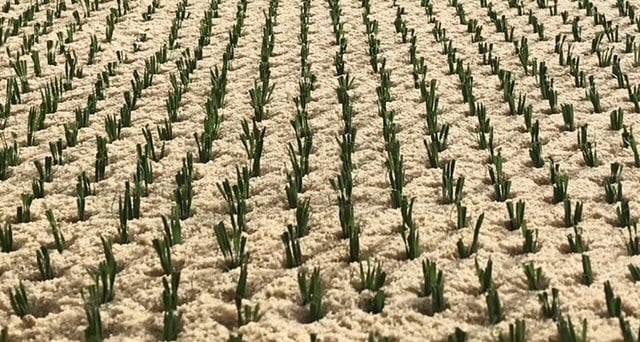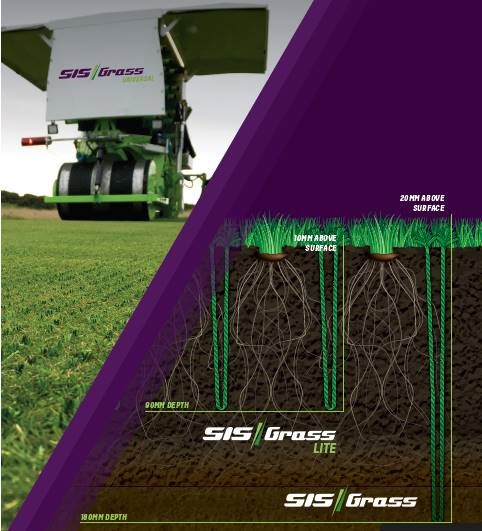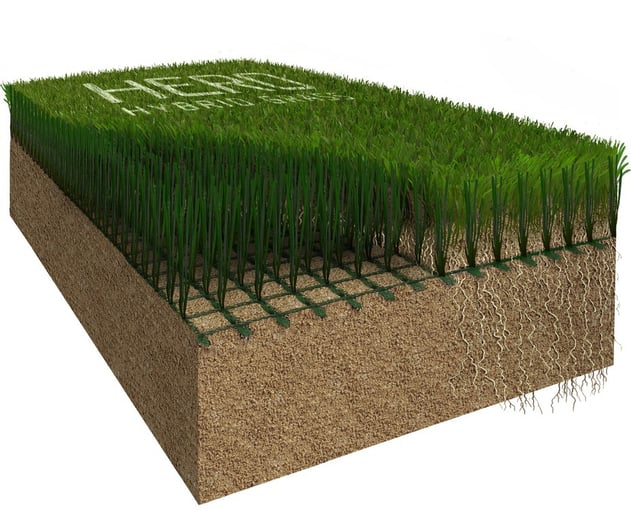A hybrid grass (or hybrid turf) surface consists of synthetic fibres that extend above the growing medium and combine with the natural turf leaves and stems. Unlike profile reinforcement products, that are contained within the profile growing medium, a hybrid grass has its synthetic fibres exposed to ‘daylight’ and subsequent wear from use on the surface.
 Close up of Desso GrassMaster by FieldTurf.
Close up of Desso GrassMaster by FieldTurf.
What are the benefits of hybrid grass?
The two main benefits of a hybrid grass surface are:
- Improved durability of the surface (particularly for cool season grasses and/or in high wear areas).
- Increased profile stability.
If the system is a mat/carpet laid product (see below), it can also be used as a “ready-to-play” profile. A “ready-to-play” profile is harvested as a thick sod profile in the turf farm, laid on site and used within a week of being laid. In fact, in many of the major stadium instances, players have used their surfaces immediately after installation.
How is a hybrid grass surface established?
A hybrid grass surface can be established via two approaches:
- Stitching synthetic fibres into an established natural turf profile using a specialised stitching machine.
- A mat/carpet laid product infilled with rootzone sand growing medium with fibres extending beyond the infill and turf established via seed (cool season) or stolons (warm season).
 Vertically stitched hybrid system (photo SISGrass)
Vertically stitched hybrid system (photo SISGrass)

Horizontally laid carpet type turf hybrid system (photo HERO Hybrid from HG Sports Turf)
Does hybrid grass impact typical maintenance practices?
The introduction of a proprietary hybrid product into a rootzone sand profile will impact some of the typical maintenance practices.
Typically, the inclusion of a hybrid product will result in the profile initially being ‘firmer’ underfoot and may require an increase in aeration processes such as vertidraining to soften underfoot. This is typically the same for all profile stabilising products.
Depending on the proprietary system there will also be the following limitations:
- The extent of the ‘kick’ of the vertidrain needs to be reduced to avoid ripping the system up
- Hollow coring may not penetrate the backing material
- Depending on the product it may retain moisture at the backing/turf interface. This can be easily managed through routine aeration practices.
What is the difference between hybrid grass profile and a reinforced profile?
Both a hybrid grass system and a reinforced profile improve the stability of a sand profile and can be established as a “ready-to-play” product.
When turf coverage is worn out due to high wear, the hybrid turf, due to its visible fibres, provides a green ‘tinge’ across the surface whereas a reinforced profile will not aid with the visual aesthetics.
If you have more questions on this topic, feel free to contact us or reach out to us using our Live Chat!

